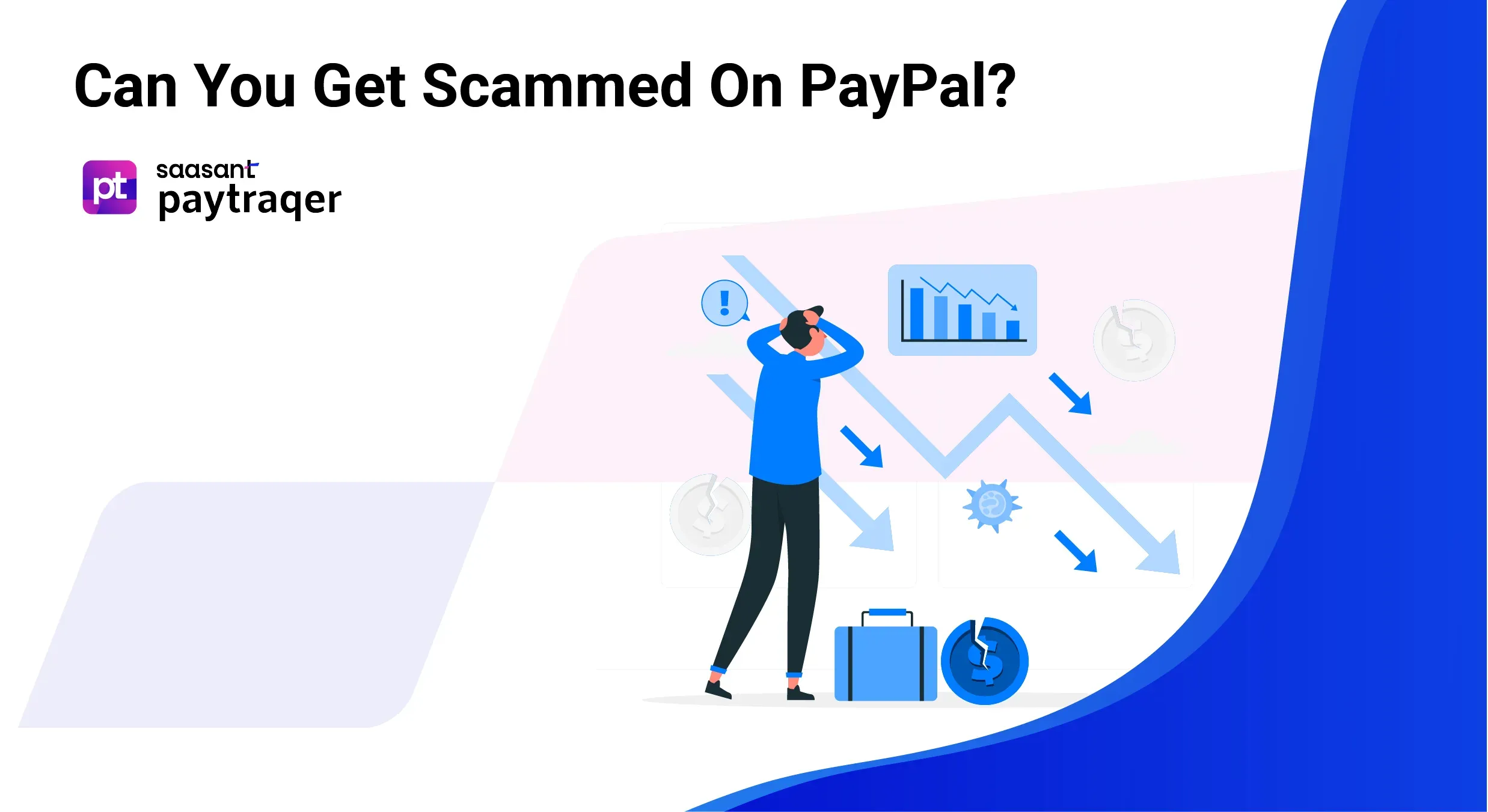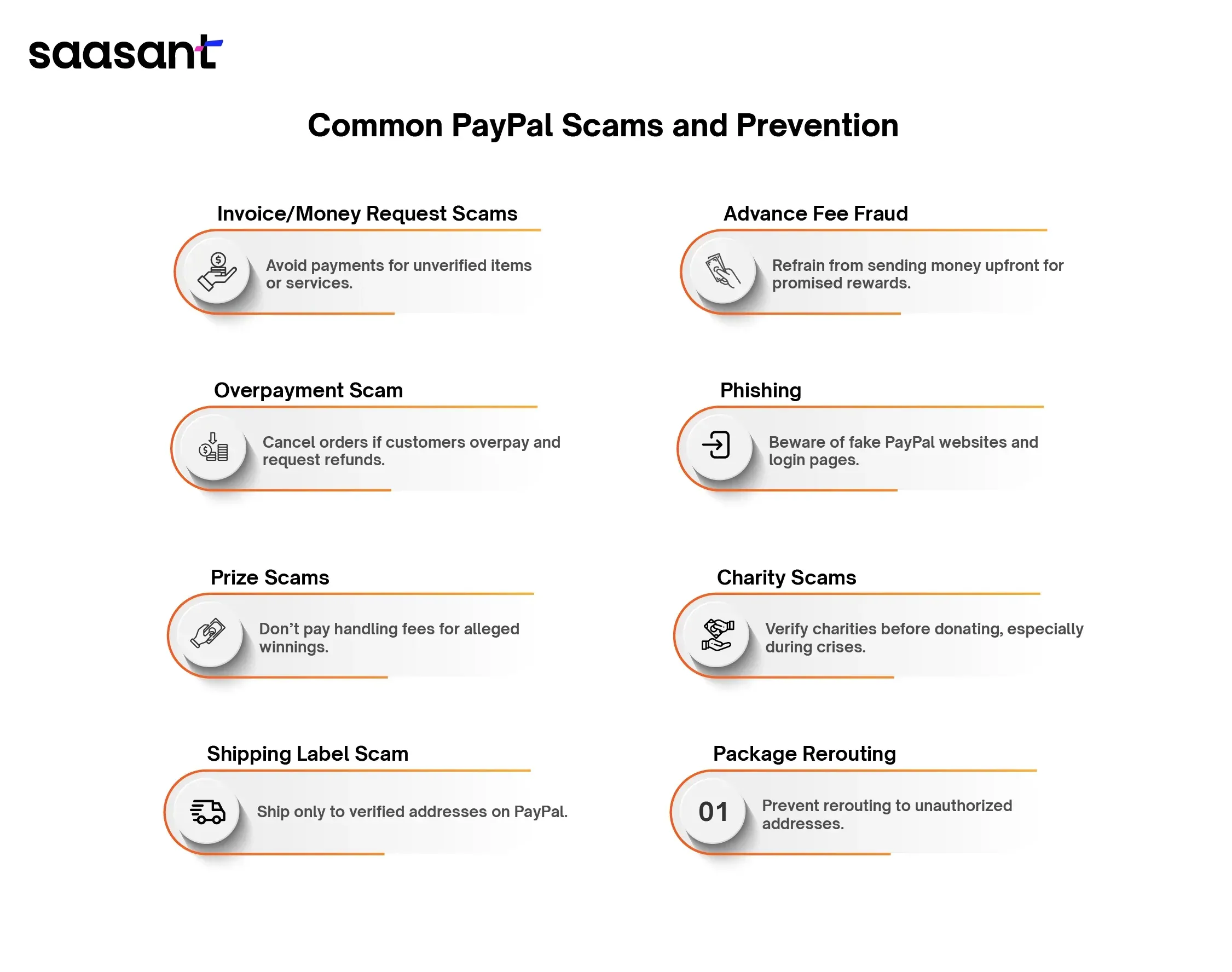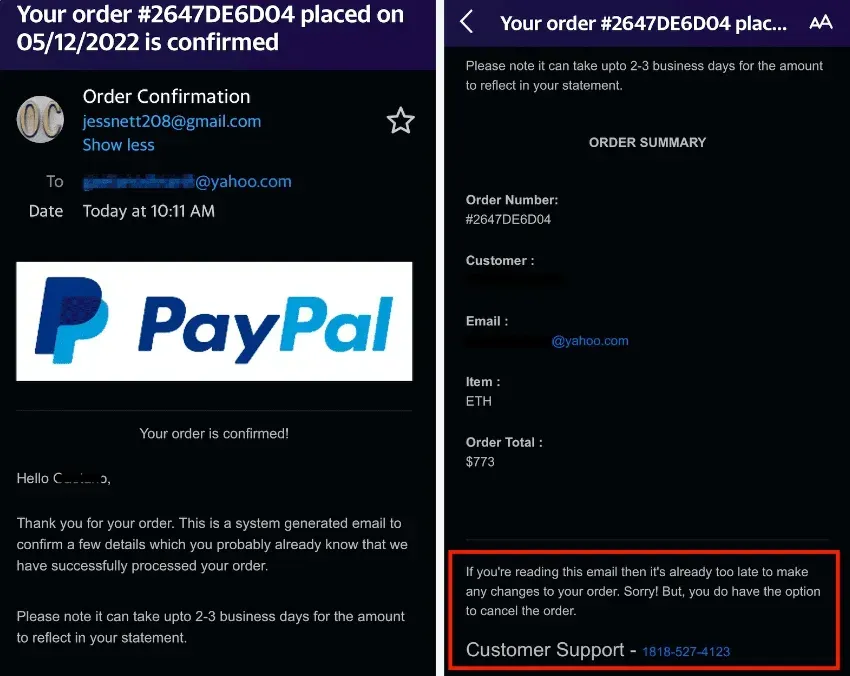Can You Get Scammed On PayPal? How to Avoid PayPal Scams?
 PayPal is a fantastic way to send and receive money online, but unfortunately, scammers are always looking for new ways to exploit its popularity. Have you ever worried about getting scammed on PayPal? The good news is that you can significantly avoid PayPal scams by following a few simple steps in the blog.
PayPal is a fantastic way to send and receive money online, but unfortunately, scammers are always looking for new ways to exploit its popularity. Have you ever worried about getting scammed on PayPal? The good news is that you can significantly avoid PayPal scams by following a few simple steps in the blog.
This blog will explain PayPal scams, including common ones, ways to avoid them, and how to protect yourself from them.
Contents
What Is a PayPal Scam? Can You Get Scammed On PayPal?
Common PayPal Scams: How to Avoid Them?
What Do You Do If You Get Scammed On PayPal?
How To Protect Yourself From PayPal Scams?
Conclusion
FAQs
What Is a PayPal Scam? Can You Get Scammed On PayPal?
The scams encompass various deceptive tactics to steal your personal payment information or trick you into sending money. They often rely on social engineering, where scammers manipulate your trust or emotions to make you click suspicious links, reveal your credit card details, or send them money directly through PayPal.
Yes, it's possible to get scammed on PayPal. Scammers can exploit the trust and familiarity associated with PayPal to trick users into making unauthorized transactions or sharing personal information. PayPal users need to stay vigilant, recognize common scam tactics, protect their account information, and report suspicious activities to PayPal immediately. To report a suspicious email or website, you can forward it to phishing@paypal.com, and PayPal will investigate it.
Common PayPal Scams: How to Avoid Them?
Identifying the common PayPal scams is vital to avoid possible risks. Let's look into the most common scams to help you identify them early and avoid falling into the deceptive tactics of scammers:

Invoice and Money Request Scams on PayPal
Invoice and money request scams can happen in various ways:
You might receive an invoice or money request via PayPal for a product, service, or cryptocurrency you never purchased. Ensure that no payments are made in such cases.
You might receive an invoice or money request through PayPal with an alarming message urging you to contact a fake customer service number provided by the scammer.
You might receive a counterfeit invoice or money request via email, mimicking a genuine PayPal communication.
These scams aim to deceive you into sending money to a scammer or providing your personal and financial information. It’s important to stay cautious of alarming messages that pressure you to call a specified number urgently to address an alleged issue with your account.
To avoid falling victim to this scam, you can;
Refrain from paying any suspicious invoices or money requests.
Avoid calling phone numbers mentioned in suspicious invoices or clicking on fake URLs.
Report any questionable invoices or money requests promptly by accessing your PayPal account through the website or the PayPal mobile app.
Advance Fee Fraud on PayPal
If you encounter an offer promising free money, there's likely a hidden trick that scammers use. Typically, scammers will request a smaller sum (such as for taxes or legal fees) before they can deliver the large sum promised, which they never intend to send.
To avoid falling for this scam, do not send money to unfamiliar individuals or strangers.
Overpayment Scam on PayPal
In an overpayment scam, a customer sends a PayPal payment exceeding the order's purchase price and then asks you to wire them the surplus amount. They may claim it was accidental, for shipping costs, as a bonus for excellent service, or to compensate for any inconvenience caused.
The scammer may have paid using a stolen credit card, bank account details, or checking account. Even if the payment appears in your account, it doesn't guarantee you can keep the money. If the rightful account holder reports unauthorized activity, the funds can be withdrawn from your account, leading to losses, including the wired money, shipped product, shipping expenses, and your payment.
To stay from this scam:
Avoid transferring money to unfamiliar parties. Legitimate buyers won't overpay for an order.
If a customer overpays and requests a wire transfer of the excess amount, consider canceling the order, as it's likely fraudulent.
Refrain from transferring money to fictitious shipping companies; this is part of the scam to extract funds from you.
Fake Websites And Login Pages
After being redirected to the fake website, sellers encounter a login page similar to the official PayPal login interface. The scammers aim to deceive sellers into entering their PayPal login details, such as their email address and password.
These fraudulent login pages capture and send the information they enter directly to scammers without the sellers' knowledge. With these credentials, the scammers illicitly access the seller’s PayPal account, posing a substantial risk of harm.
Mobile-Based Phishing on PayPal
Mobile-based phishing is another common PayPal scam. For instance, scammers might send you an unsolicited text message pretending to be PayPal's support team. These messages use similar strategies, such as urgent requests for account verification or alerts about suspicious activities.
These messages often include links that, once clicked, lead sellers to fake websites or encourage them to download harmful applications. These applications could harbor malware or keyloggers, compromising the security of the seller's mobile device and capturing sensitive data.
Prize Winnings
Scammers send messages that request payment of a small handling fee in exchange for claiming huge prizes, which are often fraudulent. After sending the handling fee, users typically receive nothing in return.
To avoid this scam, refrain from sending money to unfamiliar parties. Legitimate prizes do not require receipt payment.
Fake Charities on PayPal
Scammers use various tactics to scam users, such as donating to fake charities. This often occurs during refugee crises, terrorist attacks, or natural disasters such as earthquakes, floods, or famines.
To stay clear of this scam, thoroughly research the background of any charity to ensure your donation aids real victims.
Prepaid Shipping Label Scam on PayPal
You can encounter a scenario where a customer requests you to use their prepaid shipping label to cover the shipping costs, often claiming discounted rates. However, accepting such labels can lead to potential scams:
Using the customer's label, they gain control over the package's destination, potentially redirecting it to a different country, a PO box, or an untraceable location.
To be eligible for PayPal's Seller Protection policy, you must ship to the address specified on the Transaction Details page, not the address indicated on the customer's label.
The prepaid shipping label could have been purchased using a stolen credit card, adding another layer of risk.
How to avoid this scam:
Thoroughly review the customer's order for any signs of fraud, especially if they insist on using their prepaid label.
Do not accept shipping labels from customers to avoid potential risks.
Always ship to the address on the Transaction Details page to ensure compliance with PayPal's Seller Protection policy and reduce the risk of fraudulent activity.
Package Rerouting Scam on PayPal
The buyer manipulates the package's route to file a complaint of not receiving the package:
A buyer places an order using an incorrect or fake shipping address.
The shipping company attempted delivery but failed due to the incorrect address.
Monitoring the online tracking, the buyer notices the delivery failure.
The buyer contacts the shipping company and requests redirection to their correct address, which the company fulfills.
Subsequently, the buyer files a complaint of non-receipt.
Because the package was rerouted, you cannot prove delivery to the address specified on the Transaction Details page.
As a result, the buyer keeps both the product and the payment, and you lose the product, shipping costs, and money. Additionally, you might pay extra fees to reroute the package.
To avoid this scam
Communicate with your shipping company to prevent buyers from rerouting packages.
Verify the buyer's address is accurate before shipping.
Ship only to the address listed on the Transaction Details page to ensure compliance with PayPal's Seller Protection policy and mitigate the risk of fraudulent activities.
Example: How Does PayPal Scam Email Look Like?
The best way to understand how to recognize PayPal scams is by looking into a real-life example:

Scammers created a fake PayPal confirmation email for a fictitious order valued at hundreds of dollars in this phishing email example. However, they offered a seemingly easy solution — simply make a phone call and inform them of the mistake.
Scammers know that people are more susceptible to their tactics if they can engage them over the phone and exert pressure to act quickly. This scam email was designed explicitly for that purpose. It used the victim’s name and email, included what appeared to be a legitimate order number, and avoided requesting personal information or money to avoid creating suspicion.
However, if you pay attention, you can spot the warning signs of a PayPal scam:
The email doesn’t come from an official PayPal.com email address.
The pixelated PayPal logo indicates it was likely stolen from another source.
It creates a false sense of urgency by threatening potential consequences if immediate action isn’t taken.
The language used is awkward and inconsistent with what one would expect from an authentic PayPal email (e.g., 'If you’re reading this email, then it’s already too late to make any changes to your order. Sorry!').
It includes a fake phone number to 'cancel' the fraudulent order.
What Do You Do If You Get Scammed On PayPal?
Here's what to do if you get scammed on PayPal:
Contact PayPal to Report Scams
Access your PayPal account and visit the Support Center to report unauthorized transactions or scams. PayPal's team will investigate and assist you in filing a claim.
Keep records of all correspondence related to the scam, such as emails, messages, and transaction details. This documentation is vital for further investigations.
Report the scam to authorities
If you have incurred financial losses or suspect involvement in a fraudulent scheme, report it to local law enforcement or cybercrime units. Such reporting helps you combat scammers and contributes to broader scam prevention efforts.
How To Protect Yourself From PayPal Scams?
To ensure the safety of your funds, account, and personal information, it's always crucial that you protect yourself from PayPal scams. Follow the below steps:
Don't click on links or attachments in emails or texts claiming to be from PayPal. If you need clarification on an email's legitimacy, log in to your PayPal account directly through the official website (not by clicking a link in the email) to check for any notifications.
Always double-check the recipient's email address before sending money. Verify that the product or service you're paying for matches the description and seller information. When in doubt, feel free to contact the seller directly for clarification.
Use a solid and unique password for your PayPal account, and enable two-factor authentication (2FA) for an extra layer of security. This requires a secondary verification code when logging in, making it difficult for scammers to access your account.
Monitor your account activity frequently and report any suspicious transactions immediately.
If a buyer 'accidentally' sends you more money than agreed upon, don't be tempted to refund the difference through methods like gift cards. A legitimate buyer wouldn't request such a method. Issue a full refund using the original payment method.
If you encounter a suspected scam, report it to PayPal immediately. This helps them track and shut down fraudulent activity.
Following these steps can significantly reduce your risk of falling victim to PayPal scams and allow you to enjoy secure online transactions.
Protect Your PayPal Account from Scams
Change your PayPal password promptly, ensuring it is strong, unique, and not used elsewhere. Consider using a password manager to generate and store complex passwords. Additionally, activate Two-Factor Authentication (2FA) for added security, limiting access to your account.
Secure Your Financial Assets on PayPal
Monitor your PayPal account for any unusual activity after updating passwords. Check linked bank accounts and credit cards for unauthorized transactions. If you detect such transactions, immediately notify your financial institutions to secure your accounts and potentially recover lost funds.
Conclusion
Understanding the common ideas scammers use and following the steps outlined here can significantly reduce your risk. If you encounter anything suspicious, don't hesitate to report it to PayPal.
Streamlining your accounting process can enhance security and efficiency for those managing multiple online transactions. Consider solutions like SaasAnt's PayTraQer, which effortlessly integrates eCommerce and payment gateways with popular accounting software like QuickBooks or Xero. This seamless automation eliminates manual data entry, saving time and minimizing errors.
FAQs
Can You Get Scammed On PayPal?
Yes, you can get scammed on PayPal, often through phishing, fake invoices, or fraudulent transactions. Always be cautious about unsolicited requests and verify the authenticity of any communication that appears to come from PayPal.
Can you get scammed if someone pays you through PayPal?
Yes, it is possible to get scammed even if someone pays you through PayPal. Scammers can use various tactics to scam individuals. It includes using stolen PayPal accounts, conducting chargeback scams, or engaging in fraudulent transactions that appear legitimate initially but are later found to be unauthorized or fraudulent.
Were You Scammed on PayPal? Here’s How To Get Your Money Back
Both buyers and sellers can fall victim to scams on PayPal. However, PayPal has implemented protective policies to safeguard against various types of fraud. To get your money back:
Cancel pending payments.
Utilize PayPal's Purchase Protection plan.
Request chargebacks via your credit card issuer, depending on the scam type.
How to cancel a pending payment if you think you’re being scammed?
If your payment is in the 'pending' status, indicating that it has yet to be processed, you can cancel it and receive a refund. Here are the steps to cancel a pending payment:
Navigate to your PayPal account summary.
Locate the payment, which indicates 'pending' and '[user] hasn’t accepted yet.'
Click on 'Cancel' below the payment and then select 'Cancel Payment.'
How to use a chargeback to get money back from a PayPal scam?
If you made a payment through PayPal using a credit card or bank account, you can request a refund through chargebacks.
Notify your bank about the fraudulent transaction and request a chargeback. When PayPal receives a chargeback request, they temporarily hold the amount in the seller's account pending your bank's decision. Typically, credit card companies and banks require you to initiate the chargeback process within 60 days of the transaction.
Will PayPal refund money if I get scammed?
PayPal offers certain protections and policies to safeguard users against scams and fraudulent activities. For example, PayPal's Purchase Protection program can provide refunds if you encounter issues such as receiving an item significantly different from the seller's description or not receiving the product.
However, the specifics of PayPal's refund policies may vary depending on the circumstances of the scam, so it's essential to review PayPal's terms and conditions and contact their customer support for assistance if you believe you have been scammed.
Can you get scammed on PayPal goods and services?
While PayPal's goods and services option provides some protection by holding the seller accountable, scams are still possible. For example, a seller might not ship the items, or the items might not match the description provided.
Can someone scam me on PayPal?
Yes, individuals can still attempt to scam you via PayPal. Some common methods include phishing emails, requests for advance payments for goods or services, and fake charity donations.